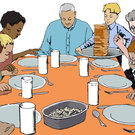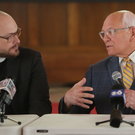Every minute counts: Don't waste your chance to save a life
As you read this, are you holding a newspaper in your hands?
Put it down and look at your hands.
Or are you reading this editorial on your smartphone? Put it down, and look at your hands.
You have two lifesaving tools at the ends of your arms, and it is easy to learn how to use them.
We are referring to cardiopulmonary resuscitation, known as CPR. For decades, since the middle of the last century, when medical science codified a system to save lives — through a combination of external chest compressions and artificial respiration — CPR was often left in the hands of experts. Doctors, nurses, paramedics, life guards, firefighters, even ski patrolmen received training and certification in doing CPR.
It is still true that cardiac arrest is a leading cause of death in the United States, but there have been two significant changes in responding. Now, constant, rapid heart stimulation is emphasized and breathing into an unconscious person’s mouth or nose is no longer stressed.
Four years ago, Lancet published a study analyzing 3,700 cardiac arrests; it found hands-only CPR saved 22 percent more lives than the conventional method. Peter Nagele, of Washington University in St. Louis, concluded that the switch could save up to 3,000 more lives a year in the United States and 5,000 to 10,000 in North America and Europe combined.
That same year, the Journal of the American Medical Association found that bystanders who did hands-only CPR boosted survival rates to 34 percent from 18 percent for those who got conventional CPR or none at all.
That leads to the second major change: The JAMA study found that the percentage of people willing to provide CPR rose from 28 percent in 2005 to 40 percent in 2009. Most bystanders are afraid they could do something wrong, according to the American Heart Association. Doing mouth-to-mouth resuscitation can be unappealing in an era when people are concerned about disease being transmitted. But, more importantly, the old method simply isn’t as effective.
The American Heart Association issued new guidelines, based on the research, that say a bystander should compress the victim’s chest 100 times a minute to a depth of about two inches. That is to keep blood and oxygen flowing to the brain until help arrives. Blood flow can be interrupted if the person administering the compressions stops to do rescue breaths.
This is a place where bystanders can make a difference — between life and death. Each year, about 300,000 Americans suffer cardiac arrests out of hospitals; fewer than 8 percent survive. The key is giving bystanders the training and confidence to intercede.
Enter: Bonnie-Jean Johnson, paramedic supervisor for Guilderland and the training center coordinator for the American Heart Association for the town. Guilderland offers four levels of training: community CPR; hands-only CPR; heart-saver CPR for police, firefighters, and camp counselors; and more in-depth training for health-care providers. Anyone who wants to sign up may call Johnson at Town Hall or email her at .
Johnson, who has been in emergency services for 18 years, credits Albany County Executive Daniel McCoy with firing up the towns to teach CPR. Two years ago, in February, which is American Heart Month, McCoy asked all the towns to train as many as they could in hands-on CPR. Guilderland trained 280 people, holding sessions at the YMCA and Crossgates Mall. This year, the University at Albany was added, and over 400 were trained, Johnson said.
Recently Johnson contacted Guilderland High School, and said Superintendent Marie Wiles was “very supportive” of CPR training. Johnson trained 27 hall monitors and is now training students. She trained over 200 this week and will return in February to train more, she said.
Johnson is passionate about her work. She described what it is like to tend to someone with no pulse, who isn’t breathing. “They are considered dead,” she said. “When you put your hands on the center of their chest and begin compressions, that is the most effective thing you can do...I’ve had people, when they get out of the hospital, tell me, ‘You saved my life.’”
Johnson has answered many 9-1-1 calls where family members are doing CPR on the person who has collapsed. “I’m always impressed when the family is doing CPR on their loved one. After you call 9-1-1 and you don’t know what to do, it empowers people. They don’t feel as helpless,” she said. It also improves the chances for survival.
“The bottom line,” said Johnson, “is, if someone collapses, first you dial 9-1-1. Then you put both hands on the middle of the chest and start compressing.”
The Guilderland students this week practiced the procedure on dummies, learning the simple steps easily. They are now prepared to use their hands to save lives. We’ve covered similar sessions run by the Albany County Sheriff’s Office, most recently at Berne-Knox-Westerlo.
We have nothing but praise for these programs. But we’d like to see them become required. Some states have made CPR training mandatory for high school graduation. Such a bill is pending in New York; we urge that it be signed into law soon.
The results can be stunning. The city of Seattle in Washington makes that clear. For one thing, Seattle has AEDs throughout the city. Those are automated external defibrillators, portable electronic devices that check the heart’s rhythm and, if needed, can send an electric shock to the heart to try to restore a normal rhythm.
Second, more Seattle residents are trained in administering CPR and using AEDs than is typical in America. They are required to take CPR training in order to graduate from high school and to get or renew a driver’s license.
Those who are educated will act.
According to the American Heart Association, the survival rate of people in Seattle who experience sudden cardiac arrest is 40 percent, compared with the rest of the country, at 8 percent. So, if you suffer a heart attack in Seattle, you are five times more likely to survive than if your heart stopped here.
Should we all move to Seattle?
A better solution would be, each of us, to make a commitment to learn this simple technique. The American Heart Association has developed a kit, which any adult or student leader can use to conduct a 30-minute CPR session. Details are available on the heart association website — www.heart.org/cpr. Or, if you live in Guilderland, you can call Bonnie-Jean Johnson.
We urge our school districts to act on this ahead of the state as Guilderland has. We know schools are already overburdened but CPR training is simple and essential. Most people don’t survive a heart attack. A bystander has just four to six minutes to react before it is too late.
One of the stories posted on the American Heart Association website is that of Monica Whittle whose husband had a heart attack in December 2011. She had learned to do CPR as a middle school student in Biloxi, Mississippi 30 years before. That training was all she needed to save her husband’s life.
It may be a stranger who collapses in front of you. It may be someone you love. Get the training now. You never know when you’ll need it. Put your hands to work. Save a life.
— Melissa Hale-Spencer


